
This site celebrates the life and work of sculptor John
Cassidy (1860 - 1939).
'Adrift' Chronology
1907
Completed. Exhibited at the New Gallery, London.
1908
Installed in the foyer of the City Art Gallery.
c.1920
Moved to the centre of the new Piccadilly Gardens.
1953, 21 April
Replaced by a fountain, and re-located to the north side of
the gardens.
c.2000
Removed to storage: area used to build an office building,
describes as a'rectilinear slab block [that] has an urban
presence that is suits its city-centre setting. It is spare, modern and
functional, yet has finely proportioned, classical undertones.'
2009, 27 March
Returned to public display.
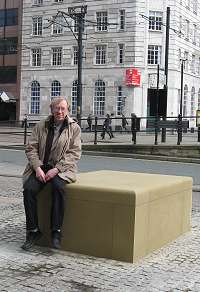
On 23 March 2009, the plinth was in place: the author took the
chance to make an appearance! In the background is Century House, an
elegant neo-classicakl building which was demolished in 2015 despite
many protests.
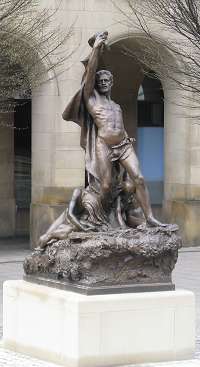
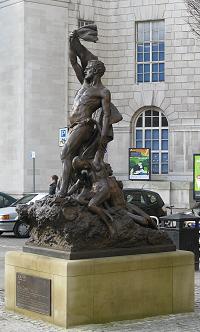
It was always intended to add a plaque to the plinth,
including Cassidy's original text, but we were informed that the Art
Gallery staff had to agree on the wording; it was the following year
that the plaque appeared. Admirers of Cassidy's work, and members of
James Gresham's family, had been promised by the Council
some sort of unveiling ceremony, but it was quietly
installed without any advance notice.
This revival would prove to be brief. Plans were in hand for a
major rebuilding of the nearby Library and Town Hall Extension, and the
site would been needed for the paraphenalia of the building contractors.
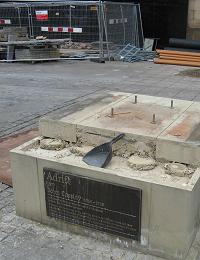
2011 March
The work was removed again into storage. We were assured it is in safe storage and will return. The building project was planned to be complete by Octobber 2013, but in the event it was some moths later.
Meanwhile, the Council has also decided to redesign the whole of the St Peter's Square area, inconjunction with the building of a new office block to replace Elisabeth House, and the exnapsion of the Metrolink station to handle the additional tram line which would connect the Square with Victoria station.
2013 March
Plans were released of the proposed new arrangement of the square, designed by a German architect, and the Council's plans were soon approved (by the Council) and work began.
2014 October
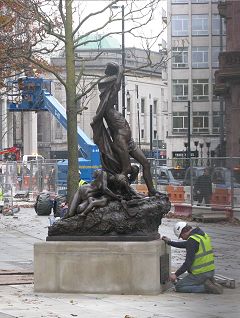
2015 November
The work on full view again.
The Struggle for Peace and Freedom
In 1988 a sculpture by Philip Jackson entitled 'Struggle for Peace and Freedom' was installed in St Peter's Square on the future site of 'Adrift'. It was the winner of a national competition which attracted 46 entries.
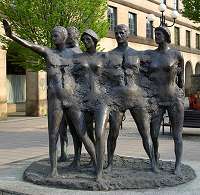
This work (above) seems to have been dogged with misfortune from the start: its planned site at the end of the nearby 'peace garden' was appropriated for a children's playground, the budget allocated (£15,000) meant that 'cold-cast' bronze (more fragile than hot metal casting) had to be used, and when unveiled it was reported that the sculptor's name was wrongly spelled on the plinth.
The figures were mounted at ground level, rendering the figures prone to graffiti and other damage. Its unfinished appearance made it unpopular with some, and after it began to deteriorate badly, 'The Burghers of Manchester' as some called it after its resemblance to Rodin's 'Burghers of Calais' has been removed, and faces an uncertain future. We believe that 'Adrift' will be installed in its place.
Philip Jackson, meanwhile, has gone on to many successes: in 2008 created a a statue of three football heroes for Manchester United Football Ground, and he was chosen to model the late Queen Elizabeth the Queen Mother for a new memorial in London, unveiled in February 2009.
The 2008 plan
The following list is from a Manchester City Council report (PDF full version) entitled 'Update on the maintenance of war memorials, civic statues and public art' dated 2 September 2008.' The report notes, accurately that renovation of Cassidy's other major Manchester outdoor work, King Edward VII, was completed according to plan in 2008.
The revenue budget for war memorials, civic statues and public art currently stands at £172,080 for 2008/09, £127,120 for 2009/10 and £127,210 for 2010/11,
as approved in the 2008/09 business planning process. Planned for 2009/11:
- Conservation of Peel and the Wellington group, Piccadilly Gardens
- Conservation of the Jubilee Fountain, Albert Square
- Installation of Adrift, St Peter’s Square
- Phase 2 Conservation of Oliver Cromwell, Wythenshawe Park
- Steam cleaning and re-gilding of busts in the Sculpture Hall, Town Hall
- De-installation of Mediterranea, Castlefield basin
- Conservation and possible relocation of Joseph Brotherton
- Phase 2 of Queen Victoria, Piccadilly Gardens
Detail views
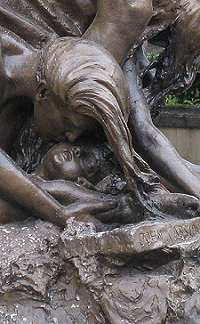
Detail of the wife and baby.
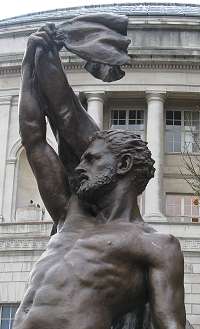
The head of the family tries to summon assistance. In 2009 he was position he was facing across the square towards Manchester's war memorial Cenotaph, designed by Edwin Lutyens, where the Remembrance Service is held every November. In 2015 he finds himself facing the celebrities and wealthy visitors emerging from the Midland Hotel.
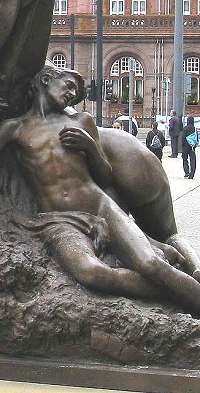
Detail abounds. In the background is the terracotta facade of the Midland Hotel, designed by Charles Trubshaw and opened in 1903.
St Peters Square in the 1960s, from an old postcard. The Cenotaph in the foreground; the new site for 'Adrift' is near where the red telephone box was, left of centre.
Other statues in Piccadilly Gardens
The four Victorian statues, all memorials, dating back to the days of the Royal Infirmary, along the eastern periphery of Piccadilly Gardens, survived the makeover. Links are given to the Public Monuments and Sculptures Association record for each:
The Wellington Monument (1856), by Matthew Noble
Queen Victoria Monument, (1901) by Edward Onslow Ford
Robert Peel (1853), by William Calder Marshall.
James Watt (1857), by William Theed the Younger
Here is a link to a very interesting article about these works, written by Bob Speel.
Links and references:
Aidan O'Rourke photography
Piccadilly Gardens 'Muddy Awful' : Manchester Evening News, 2007
Shipwreck sculpture back on show': Manchester Evening News, 2 Aporil 2009.
BBC panorama of Piccadilly Gardens
A very fine photograph of 'Adrift' in its new location, by Steven Heaton.
St Peters Square, by Manchester City Council
Buildings on Wikipedia:
J.J. Parkinson-Bailey, Manchester: an architectural history. Manchester University Press, 2000.
Derek Brumhead and Terry Wyke. A walk round Manchester sculptures. Walkround Books, 1990.
'Adrift' - City of Manchester
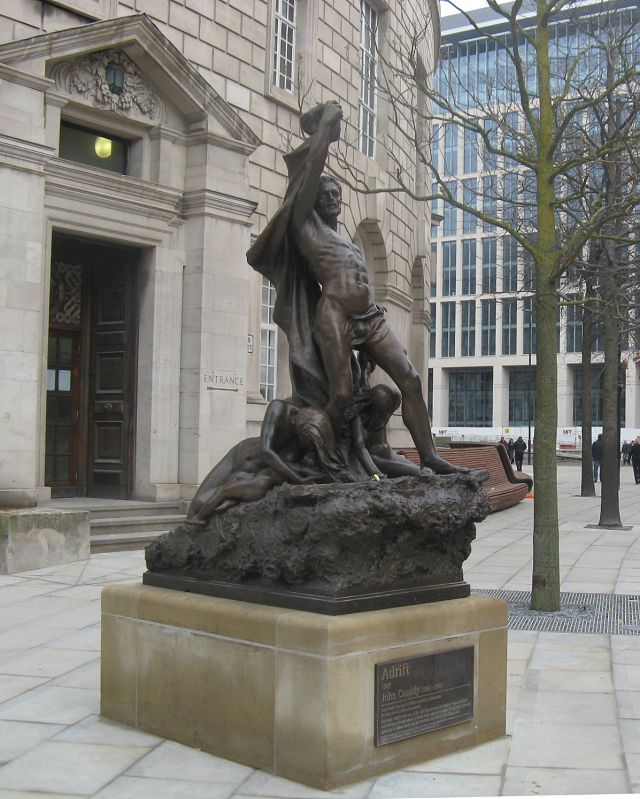
To describe this striking work, seen above in its new location in 2014, we can do no better than quote the Public Monument and Sculpture Association National Recording Project, describing 'Manchester's first modern figurative outdoor sculpture':
Signed 'John Cassidy fecit 1907' it was exhibited at the New Gallery in London in that year. Rarely since his student days was Cassidy able to create anything other than portraits or memorials, and this is certainly his major work of 'pure' art. Showing the influence of the so-called 'New Sculpture' movement, on his thinking, the scene depicted is full of action.
It was purchased by James Gresham, a wealthy local engineer who collected many works by living artists - perhaps it was also commissioned by him. Gresham offered it as a gift to the City Council with the intention that it would be displayed in the new municipal art gallery that was to be built on the site of the Royal Infirmary in Piccadilly, which was in process of relocating to a new site on Oxford Road. The donation had the proviso that 'my gift of this statuary to become absolute when a permanent home is found for it in your new gallery.'
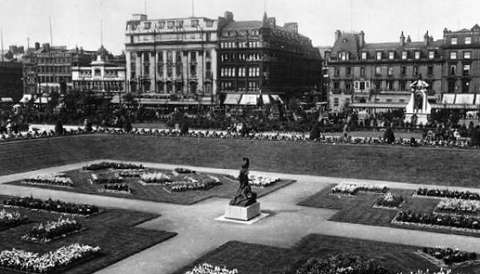
The new gallery never appeared, and City's Art Gallery remaining in Mosley Street, but the statue did come to grace the site, removed from the Gallery loaned to the Parks department after World War I, and becoming the centrepiece of the 'sunken garden' which was created there, as seen in the postcard view above.
This garden, which gave its name 'Piccadilly Gardens' to the area, with its beautiful floral displays, and seats where weary shoppers could take their rest, was the pride of the City's gardens department and was enjoyed by many people over the years.
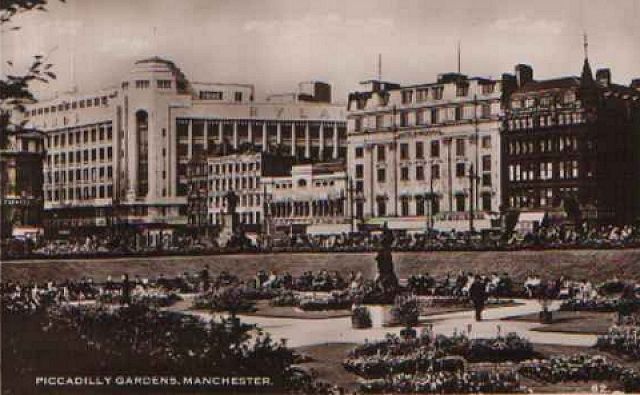
This postcard view is later than the one above, probably dating from the the early 1950s. The Rylands & Sons warehouse, designed by Harry S. Fairhurst, and constructed from 1929 to 1932, looms over the far corner of the gardens. (Note the radio mast on the roof.) This building was one of the last of Manchester's great cotton warehouses to be built, and one of the few to use a 'modern' style rather than taking inspiration from the past. Rylands and Sons was the firm established by John Rylands, subject of another Cassidy sculpture. In the 1950s, it was converted to a department store for Paulden's, whose own store, near the Manchester School of Art, had been destroyed by fire. Today it is known as Debenhams - the company had taken over Paulden's business in 1928, but continued to trade in Manchester as Debenhams until about 1970.
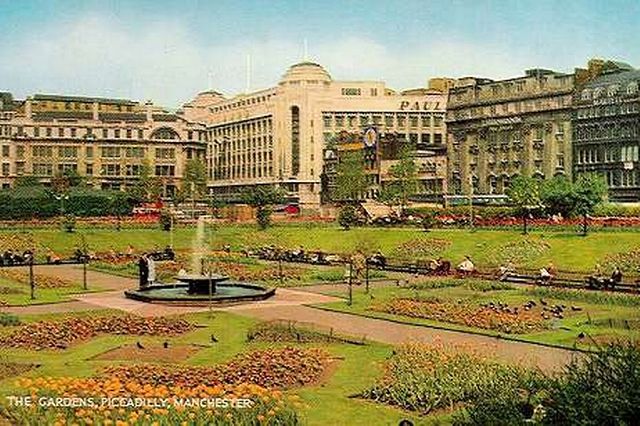
Manchester decided to commemorate the coronation of Queen Elizabeth in 1953 with a fountain, which was erected in the centre of the gardens in place of 'Adrift' - as seen in the postcard view above ... which causes waves of nostalgia to wash over the present writer. Wiles' toyshop on the corner across the road from Paulden's was the highlight of any visit to the city, perhaps preceded by lunch in Woolworth's self-service restaurant and a sit in the gardens until near the time for our hourly train home to depart from Piccadilly Gardens.
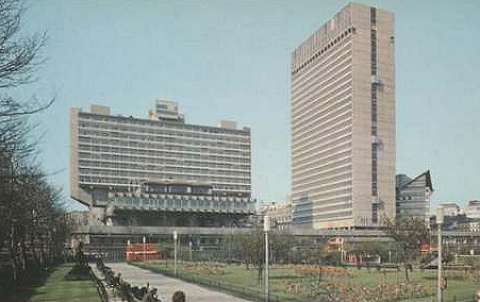
'Adrift' was relocated, on 21 April 1953, to the grassed ground-level area (in the foreground of the old picture) at the south end of the gardens, where it can be glimpsed towards the bottom left of the view above, against a backdrop of the futuristic buildings erected in the 1960s to replace those destroyed by enemy bombing at Christmas 1940.
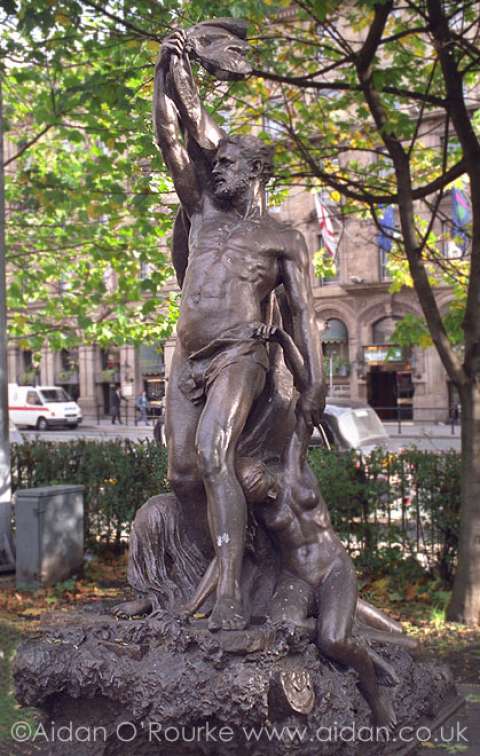
It was here that the above picture of 'Adrift' was taken in 1998 by Aidan O'Rourke, who we have to thank for allowing us to include it, and indeed for all the marvellous work he does in compiling a photographic record of the Manchester area, and encouraging discussion about our built environment.
The gardens, and in particular the sunken area with its long benches (which, readers will note from the oldest picture on this page, were not originally present) became seen by the late 1990s as a haunt of so-called 'undesirables'. (Maintenance of flowerbeds no doubt cost money, too.) So in the wake of the 1996 bomb attack on the city centre, and in preparation for the 2002 Commonwealth Games in Manchester, it was decided to carry out improvements to the gardens. A competition was held to choose a new design for the area. The winners – announced in 1998 – were the landscape architects EDAW and their partners: the engineers Arup, Japanese architect Tadao Ando, local architects Chapman Robinson, and lighting engineer Peter Fink.
Unfortunately, in order to fund this project, it was decided to allow the speculative building of a new and ugly office block, known as No.1 Piccadilly, on the level area at the south end, thus losing green space, a rare thing in the centre of Manchester. The 'improvements' to the sunken part of the gardens, completed in 2002, involved filling in the sunken area to normal ground level, and creating a large lawn with a geometrical arrangement of paths and water features (by EDAW), and new a long, low curved building (the 'pavilion') on the west side including some eating places, which presents a bare concrete surface reminiscent of the the Berlin Wall to people to passengers at the Metrolink tram station beyond. Not a flower in sight - except on days when a flower market is held nearby. And ... we still read reports of drug dealers and other problems.
The Coronation Fountain of 1953 was rescued and placed in Platt Fields park - in Fallowfield, not far, as it happens, from John Cassidy's last home in Albion Road - with a rose garden planted around it, for the Queen's Golden Jubilee in 2002.
'Adrift' disappeared into Council storage, but after some years, and discussion about what to do with it, at the end of March 2009 it was back in public view, in a prominent location in St Peters Square (above).
The original plinth of 1908 is said to have carried a plaque with the following inscription:
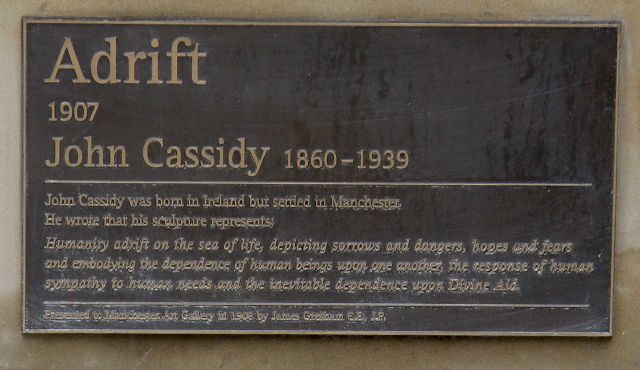
This plaque seems to have vanished many years ago: however, a replacement was created and installed some months after the work first re-appeared. It also includes a brief biographical note on Cassidy and a Credit to Gresham.
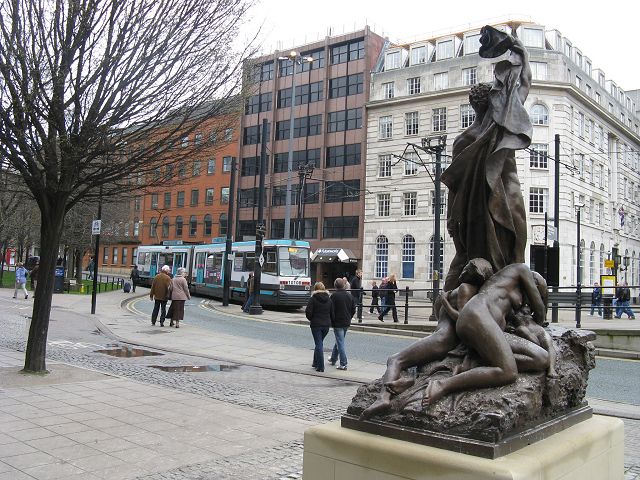
The new location was by the busy transport hub of St Peters Square in the centre of Manchester, and a short walk from the city's Art Gallery, the first home of 'Adrift' - just out of the view to the left in the 2009 view above.
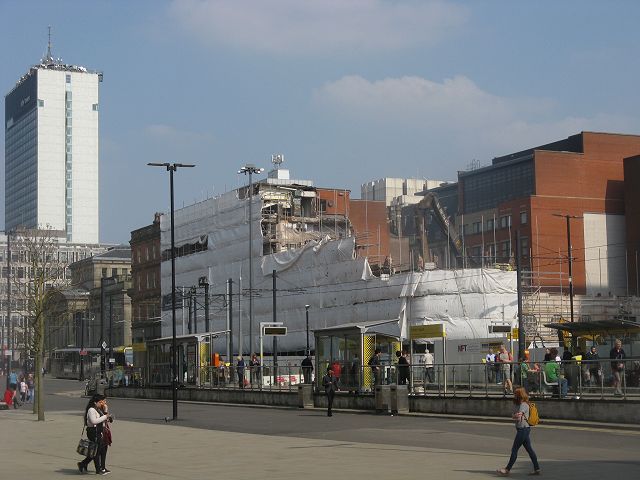
A 2015 view of the same area shows the buildings in the background, including the classically-styled Century House, being demolished. The portico to the left of the view belongs to the City Art Gallery.
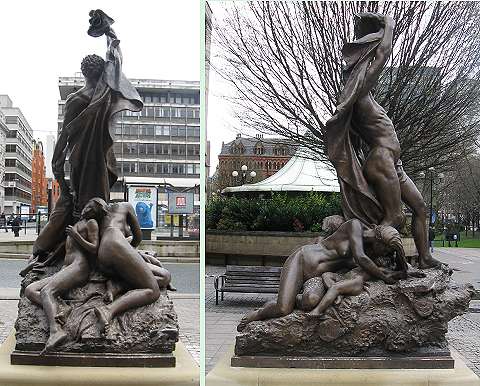
The work seen from all four sides in 2009. The tent-like structure in the background of the right-hand view was part of a children's play area. The building in the background of the left-hand view, Elisabeth House (1960) apparently should have had stone facing, but the developers ran out of money. It looked forlorn, and almost empty in 2009 and was demolished in 2011-12, to be replaced by a new, larger, bulding.
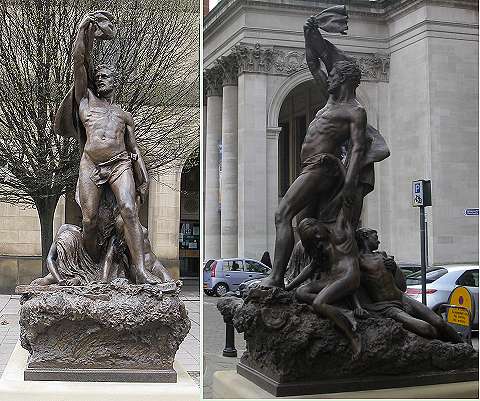
The square is home to some of Manchester's most memorable buildings: the classical portico in the right-hand view (above) belongs to the Central Library, designed by E. Vincent Harris and completed in 1934.
The arcades are part of the 1930s Town Hall Extension, also designed by Harris, which harmonises with Alfred Waterhouse's adjoining Town Hall in Albert Square. (See our Albert Square page.)
St Peter's Church. built 1788-94 and demolished in 1907 to create the Square, stood in the centre of the square: the buildings in the background here were built after World War II. The developers are the same group who put the bland new office block on Piccadilly Gardens where 'Adrift' used to be: the resulting building has become controversial due to its large size which some see as inappropriate.
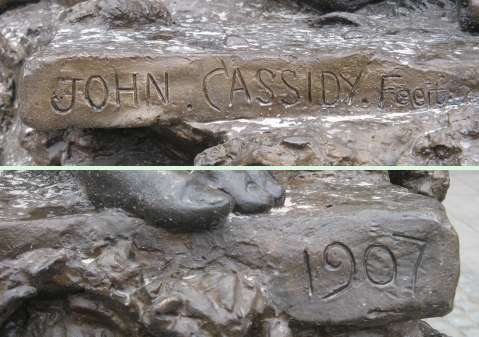
Cassidy has signed 'Adrift' in his usual way. 'John Cassidy Fecit ... 1907.' 'Fecit' is Latin for 'he made it' and was used my many artists and sculptors in older times.
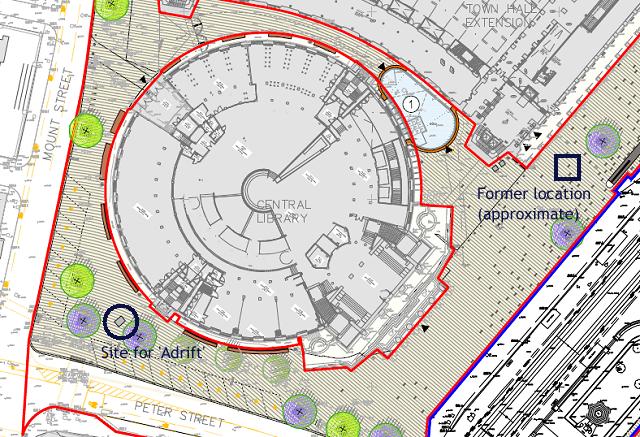
The developer's plan of the revised St Peter's Square, showing the former and current locations of 'Adrift'.
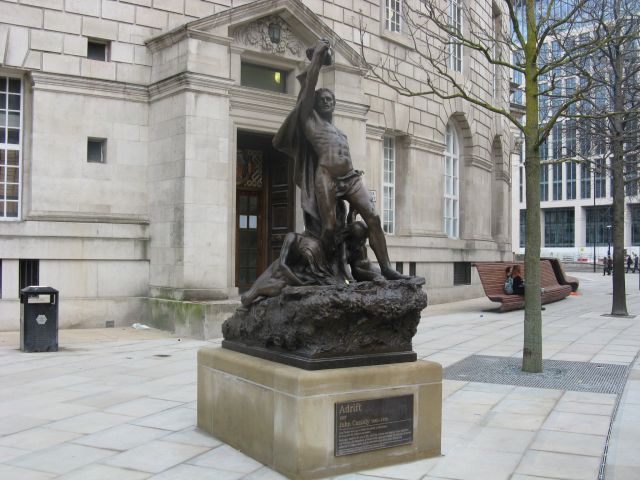
The work in place, November 2014.
Written by Charlie Hulme, Updated April 2015.